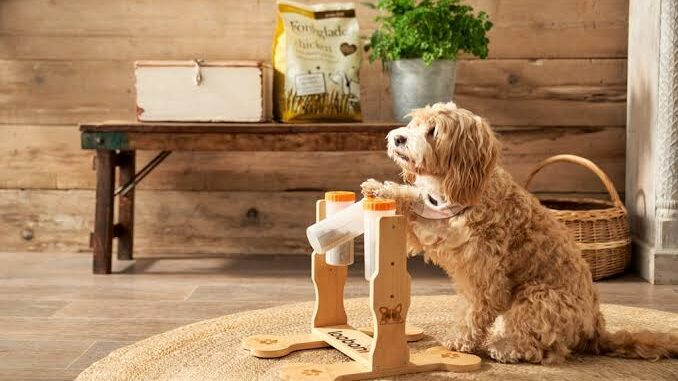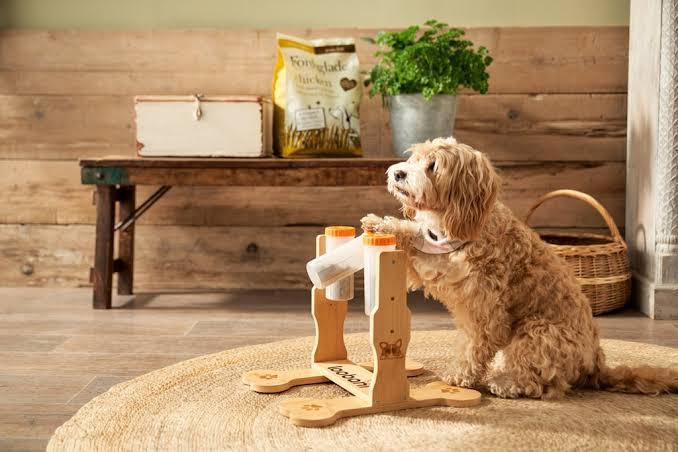
5 Fun Games to Mentally Stimulate Your Dog: Dogs are incredibly intelligent and emotionally intuitive creatures. While physical exercise like walks or runs is important, mental stimulation is just as essential to keep your dog happy, healthy, and well-behaved. Dogs who are mentally challenged and engaged are less likely to become bored, anxious, or destructive.

Engaging your dog’s brain through games improves their cognitive functions, sharpens obedience, reduces behavioral issues, and strengthens the bond between you and your furry friend. Whether you have a playful pup, a clever retriever, or a senior dog, the following five games are fun, adaptable, and packed with mental enrichment.
Why Mental Stimulation is Important for Dogs
Mental exercise is just as critical as physical activity. Here’s why:
- Reduces boredom and anxiety: Dogs left mentally idle may chew, bark excessively, or dig out of frustration.
- Enhances learning and memory: Games help reinforce commands and develop new skills.
- Improves behavior: A stimulated dog is less likely to engage in undesirable behaviors.
- Builds confidence: Especially in shy or anxious dogs, problem-solving games can boost confidence.
- Slows aging: For senior dogs, brain games may help stave off cognitive decline.
Let’s dive into the top five games that deliver both fun and stimulation.
1. The Shell Game (Cup Game)
Goal: Teach your dog to find a hidden treat under one of three cups.
How to Play:
- Choose three cups (identical in shape and size).
- Place a treat under one cup while your dog watches.
- Shuffle the cups slowly (especially at first).
- Let your dog sniff and paw at the cup they think holds the treat.
- Lift the cup to reveal whether they were right.
As your dog gets better, increase the speed and number of cups. You can even try sleight-of-hand tricks for advanced levels.
Benefits:
- Enhances scent-tracking ability.
- Improves memory and problem-solving.
- Encourages focus and patience.
Pro Tips:
- Start slow with just two cups.
- Use high-value treats for better engagement.
- Reward even attempts in early stages.
2. Snuffle Mat Treasure Hunt
Goal: Encourage natural foraging behavior by hiding kibble or treats in a snuffle mat.
How to Play:
- Buy or make a snuffle mat—a fabric mat with fleece strips that hide treats.
- Scatter kibble or treats deep into the mat.
- Let your dog sniff, snuffle, and search for every last piece.
This game mimics the way dogs hunt for food in nature.
Benefits:
- Triggers natural instincts.
- Reduces fast eating.
- Calms anxious or high-energy dogs.
Pro Tips:
- Use as a slow feeder for meals.
- Clean the mat weekly to maintain hygiene.
- Use varied treats to keep it exciting.
3. Hide and Seek (with Humans or Toys)
Goal: Encourage problem-solving and scent work by having your dog find a hidden person or object.
Version 1: With You
- Tell your dog to “stay” while you hide in another room.
- Call their name once and wait.
- When they find you, praise and reward.
Version 2: With Toys or Treats
- Show them a favorite toy or treat.
- Let them watch you hide it under a pillow, behind a door, or in another room.
- Say “Find it!” and encourage them as they search.
Benefits:
- Sharpens recall and obedience.
- Strengthens your bond.
- Provides a full-body mental workout.
Pro Tips:
- Start with easy hiding spots.
- Use consistent cues like “Find me!” or “Where’s your toy?”
- Make it a daily game to reinforce training.
4. Puzzle Toys and Treat Dispensers
Goal: Engage your dog in solo play that requires logic to get a reward.
How to Play:
- Fill a puzzle toy (like a Kong, Nina Ottosson, or treat ball) with peanut butter, treats, or kibble.
- Present it to your dog and watch them figure out how to get the reward.
- For extra challenge, freeze the toy with the treat inside.
There are puzzle toys for every level of difficulty, from beginner to advanced.
Benefits:
- Builds independence and confidence.
- Keeps dogs busy for long periods.
- Helps with crate training and meal-time enrichment.
Pro Tips:
- Rotate toys to keep them novel.
- Supervise at first to ensure safety.
- Adjust food quantity to avoid overfeeding.
5. Tug with Commands
Goal: Combine physical play with impulse control and obedience training.
How to Play:
- Initiate a game of tug-of-war using a durable tug toy.
- Randomly issue the command “Drop it” or “Sit” during play.
- When your dog obeys, resume play as a reward.
This game becomes a dynamic balance between stimulation and control.
Benefits:
- Reinforces commands under excitement.
- Provides a healthy outlet for energy.
- Deepens trust and responsiveness.
Pro Tips:
- Use tug as a reward for good behavior.
- Always let the dog win sometimes to keep motivation high.
- Use commands like “Take it,” “Drop it,” and “Wait.”
READ ALSO: The Mystery of the Tortoiseshell Cat: A Tale of Colors, Myths, and Meaning
Making Brain Games Part of Your Daily Routine
It doesn’t take long to mentally stimulate your dog—just 10–15 minutes a day can make a world of difference. Here are ways to build these games into your routine:
- Use puzzle feeders for breakfast.
- Play Hide and Seek before your morning walk.
- End the day with a calm snuffle mat session.
- Keep a puzzle toy for solo play while you work.
Rotate games to prevent boredom. Variety is just as exciting for dogs as it is for us!
Tips for Success
- Know your dog’s limits: Don’t push too hard or make games too difficult too soon.
- Be patient: Dogs learn at different speeds. Praise effort, not just success.
- Use positive reinforcement: Always reward with treats, praise, or play.
- Make it fun: Don’t turn games into a strict training session. Keep the vibe light and playful.
- Avoid overstimulation: If your dog seems anxious or overwhelmed, take a break.
FAQs
How often should I play brain games with my dog?
Ideally, aim for 10–20 minutes daily. You can spread this out over multiple short sessions to keep it manageable and fun.
Are brain games good for all breeds and ages?
Yes! While high-energy and working breeds may need more mental stimulation, all dogs benefit from it—puppies, adults, and seniors alike. Just tailor the difficulty to their level.
What if my dog loses interest quickly?
Try using higher-value treats, change up the game, or shorten the session. Some dogs need extra motivation or simply prefer certain types of games over others.
Can brain games help with behavior problems?
Absolutely. Many behavioral issues stem from boredom. Mental stimulation helps reduce destructive behaviors, separation anxiety, and excessive barking.
Is it okay to use food in every game?
Yes, especially during training. However, you can also use toys, praise, or play as rewards to prevent overfeeding.
How do I make a snuffle mat at home?
Use a rubber sink mat with holes and thread fleece strips through each hole. Tie the strips in knots to create a dense surface. It’s cheap, fun, and customizable.
What if my dog is not food motivated?
Use favorite toys, physical affection, or verbal praise as rewards. Tug-of-war, fetch, or hide-and-seek are great non-food-based games.
Leave a Reply
You must be logged in to post a comment.